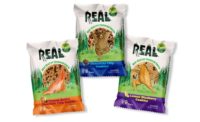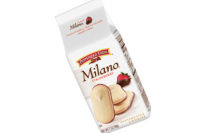![]()
Sugar-Free Superstars
By Renee M. Covino
The low-carb craze may have fans that fade, but confections
with low or no sugar seem to have a rock-solid following.
Forget when sugar-free
candy was buried in the back of the store, invisible to all but those
(typically diabetics) who longed for some sweet facsimile, even though it
didn’t really taste the part. Fast-forward to last year, when in the
midst of a consumer low-carb frenzy, as well as the food industry’s
successful development of better-tasting and more sophisticated sugar
substitutes, sugar-free and/or low-sugar candy finally got its big break.
At last, candy manufacturers had both the means and the audience for
sugarless superstardom. And now there seems to be no looking back.
While some low-carb-claim products can technically be
included in this group, and may have even given rise to low- and
no-sugar’s jumpstart, experts believe that the continuing trend is
for low-sugar products.
Backing up that trend is the improved technology
behind sweeteners such as Splenda (sucralose)—a no-calorie artificial
sweetener that is made, in part, from real sugar and has raised fewer
consumer concerns than some others. Other recent introductions of
high-intensity sweeteners have also been well received, and the market for
alternative sweeteners is believed to hold great potential.
Back in the confectionery circle, companies such as
Jelly Belly (which last year changed its sugar-free line to use Splenda)
are raving about their sugar-free sales results. Since the Splenda change,
sales are up 51 percent, according to Pete Healy, vice president of
marketing at Jelly Belly.
Overall, “diet candy” has seen enormous
leaps in sales. For the 52 weeks ending August 8, 2004, the category grew
66 percent in dollar sales and 70 percent in unit sales (in supermarkets,
drugstores and mass merchandisers excluding Wal-Mart), according to
Information Resources Inc., reaching a sales total of $252 million.
Health consciousness counts
“Low-carb by name may not continue to dominate
the headlines, but what will continue to grow is the consumers’
consciousness towards their diets,” believes Armand Hammer, president
of Innovative Candy Concepts, an Atlanta-based candy company that this
summer completely revamped its successful Too Tarts and Suck Ups
kids’ novelty candy lines to Too Tarts Smart Choice and Suck Ups
Smart Choice, containing no refined sugar.
“We match our candy offerings with what
consumers are looking for—and lately, they’ve been very
specific about what they want in diet candy,” says Tom Ward,
president of Russell Stover Candies. “Last year they were screaming for low-carb, and our low-carb candy sales continue to grow,
but we have always sold sugar-free, and it is sticking like never before.
We believe we will continue to see especially strong growth in
sugar-free.”
Most candy manufacturers view sugar-free and low-carb candies
as distinct in formulation and marketing strategy. According to the marketing
team at Simply Lite Foods, “Sugar-free candies generally have more polyols
and the products do not contain sugar. Low-carb products may contain some sugar.
Low-carb products can contain bulking agents that may contain sugar, which sugar-free
products can not. Low-carb is usually low in sugar, but it is not necessarily
sugar-free.”
And it is because of diabetics, that most companies market sugar-free products very distinctly.
And it is because of diabetics, that most companies market sugar-free products very distinctly.
“We don’t want our diabetic
consumers coming to the conclusion that they can eat our low-carb products
or that low-carb and sugar-free are one in the same, because they’re
clearly not,” says Ward. “Some low-carb candies could hurt a
diabetic, so we don’t ever co-mingle the concepts.”
Beyond sugar-free
In fact, Russell Stover has done the opposite.
It’s created even more distinct lines within its diet candy offering.
It is currently testing a low-calorie candy line called “Calorie
Smart,” with a 25- to 36-percent reduction in calories from its
regular candy line. The forward-thinking candy company has even come out
with two lines that include the glycemic load and index on the package
information—a line called Sucratrol, sold under the Whitman’s
banner and a line called Diabet-X, sold under the Russell Stover banner.
“These are sugar-free items designed with vitamin enhancements such
as zinc and chromium, specifically for diabetics that get depleted of these
nutrients,” explains Ward. “Additionally, they have the
glycemic load, which is a first in the United States.”
Even though other candy companies may not have such
diet-savvy lines in terms of product labeling yet, they are aware of how
much more educated diet candy consumers have become, and they are reacting
accordingly.
Madelaine Chocolate Novelties Inc., which makes
gourmet and upscale chocolate items especially for the holidays, has
recently started catering to customers looking for diet versions of its
popular offerings.
“We’re making no-sugar-added items
available,” states Joan Sweeting, national sales manager of the
Rockaway Beach, N.Y.-based company. “We thought about calling it
sugar-free, but we are much more comfortable calling it no-sugar-added
because there are traces of sugar in the milk that goes in the
chocolate.”
Believe in the Tooth Friendly?
“When you buy a sugar-free item in the United
States, how do you know immediately that it’s sugar free?” asks
Julia Penkoba, director of business development for Ferndale USA, a
division of Australia-based Ferndale Confectionery. With Ferndale’s
candy products such as Jols Pastille fruit-flavored small chewable candies
that contain no sugar, no fat and are low in calories, it’s easy. The
click-shut candy box sports a logo of a happy-faced tooth with an umbrella
over it—indicating it is “tooth-friendly” and
independently tested and accredited by the International Dental
Association, which means it proved to be harmless to the teeth.
Will something like this catch on with American-made sugar-free
candies? “It should,” says Penkoba. “America is just waking
up right now to what countries like Australia have been touting all along—sugar-free
confectionery items that are not marketed in a diet candy section, but are part
of a healthy everyday candy, which happens to be sugar-free.”


